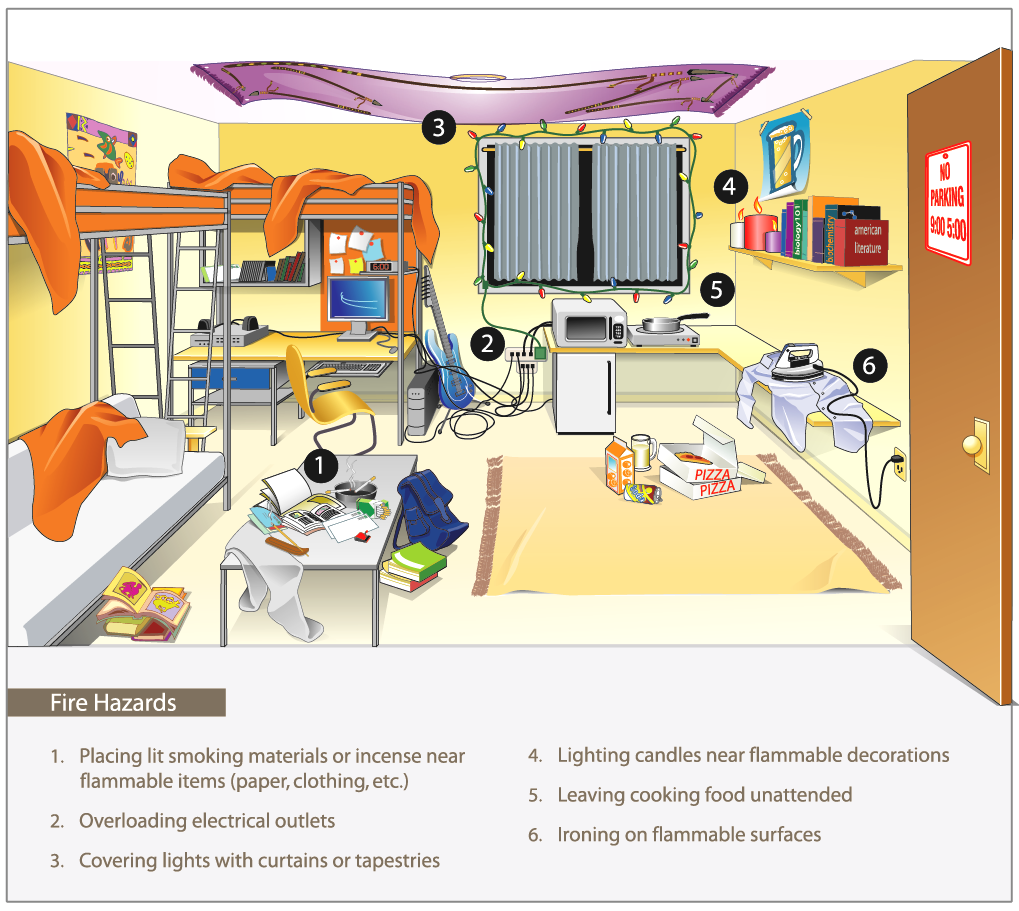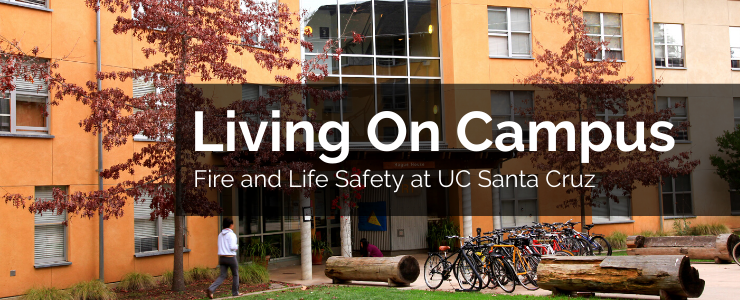Living On Campus
Fire Safe Campus Housing - What to Look For and Ask?
UC Santa Cruz houses thousands of students every year. Campus housing covers possibilities ranging from apartments to campers in order to give students as many options as possible. One of the paramount fixtures of campus housing is the assurance of student safety. This page will provide a breakdown of what safety features are available in campus housing. Additionally, we will cover important steps to ensure that your time living on campus is fire safe!
Building Safety Features
This section will cover safety features available in campus residence halls and apartments. Information about what is available for camper users can be found at the bottom of this page.
Building safety features are designed to prevent and mitigate the effects of emergency situations. In particular, all campus housing units are equipped with fire sprinklers and fire alarms. Carbon monoxide detectors are equipped in all campus housing units that have gas-fed appliances such as stoves and ovens.
Fire Sprinklers
Fire Sprinkler systems are installed in all on-campus housing units. They function as rapid firefighting equipment that can quickly subdue small fires before a dedicated response occurs. Fire Sprinklers generally take advantage of the fact that hot air rises. When the air near a fire sprinkler nozzle approaches between 135 and 165 degrees Fahrenheit, a bulb blocking water flow bursts and pressurized water douses a wide area around the sprinkler.
A single fire sprinkler can discharge 10-25 gallons of water in one minute. If it doesn't completely subdue a fire, it mitigates the flames, limits the development of smoke, and prevents nearby material from being easily combustible fuel for the fire. Fire Sprinklers are an incredibly useful apparatus for firefighting.
An important consideration is that fire sprinklers are only as effective as the range of their reach. If you have furniture or other obstructions blocking the path of the sprinkler, that limits the effective range. Make sure that you obey UCSC Housing Policies (§V.M.6) and avoid obstructing your fire sprinklers! Additionally, fire sprinklers should not be used for hanging clothes or any other items.
Fire Alarms
Fire alarms are early warning devices that indicate when a fire is developing. They can be triggered through the automatic detection of smoke or heat. Alternatively, they can be manually triggered by nearby Fire Alarm Pull Stations.
An essential component of the fire alarm apparatus, smoke alarms detect low levels of smoke through ionization or photoelectric processes. Upon detection, they emit a loud alarm designed to alert those inside the structure of the danger.
Fire alarms are set up on campus in a multitude of configurations. Many residence halls have 'networked' fire alarms. This configuration allows for all local fire alarms to trigger after a single fire alarm is activated. This allows for rapid notification of an entire area's inhabitants of potential danger.
Another way that fire alarms are set up is the singular configuration. In this configuration, the fire alarm is not networked and only functions to alert people in the immediate vicinity of potential danger.
Carbon Monoxide Detectors
Carbon Monoxide (CO) is an invisible, odorless, and colorless gas created by the burning of fuels such as in cars, trucks, stoves, lanterns, grills, fireplaces, gas ranges, or furnaces (CDC). Carbon Monoxide is lethal in sufficient quantities and can kill without symptoms for those who are asleep or under the influence of alcohol. Carbon Monoxide alarms are devices that detect when a dangerous level of CO exists within range. On detection, CO alarms will emit blaring sounds similar to those of a smoke or fire alarm.
At UCSC, all residential facilities where fuels are present have carbon monoxide alarms.
When a Carbon Monoxide alarm sounds, your first priority should be fresh air and informing anybody else in the home of the danger. Open windows and sliding doors. Ensure that there is fresh air coming into the area. If this is not possible, leave and call for help from an area where there is fresh air.
More Information
Campus Fire Safety - Fire Sprinklers (PDF)
NFPA - Fire Alarms in Apartments (PDF)
NFPA - Carbon Monoxide Safety (PDF)
NFPA - Deaf and Hard of Hearing Smoke Alarms (PDF)
Emergency Preparedness
On every housing unit on campus, there is a map mounted beside every door or living area. This map is called the Emergency Evacuation Map and provides detailed instructions on where to go in the event of an emergency. You should familiarize yourself with this map and how to follow it upon moving into your campus residence.
The Office of Emergency Services provides a detailed array of resources specific to the various potential emergencies that can be experienced while on campus. For more information, visit the Emergency Preparedness Section.
The Designated Campus Fire Marshal partners with UC Santa Cruz Housing to provide comprehensive emergency training for RAs and other housing staff members. This training helps connect the emergency procedures laid out by OES with the individuals responsible for executing them in the midst of an emergency.
Housing Evacuation Drills
Within the first ten academic days of the school year, the Designated Campus Fire Marshal administers housing evacuation drills for every part of on-campus housing. These drills are also offered during the Summer session and provide an opportunity to practice the evacuation procedure.
These drills are generally announced beforehand and it is highly recommended that all residents of on-campus housing participate. Knowing how to evacuate and react in an emergency enhances your safety and the safety of those around you!
More Information
Campus Fire Safety - Know Your Escape and Practice It (PDF)
Setting Up Your Living Space
Once you move into your new space on campus, it is essential that you take steps to ensure safety and emergency preparedness throughout your time on campus! When configuring your room, take a look for common hazardous practices shown here:

Avoiding these practices will make your living arrangement more easily accessible and less prone to danger. In addition to following these practices, make sure that you do not cover or obstruct smoke detectors installed in your residence.
Finally, make sure that your residential unit is equipped with a smoke detector and a fire sprinkle. If you notice the absence of either or potential damage, please report it immediately to CHES-Facilities Maintenance using a FixIt Ticket.
More Information
Campus Fire Safety - Building Fire Safety Features (PDF)
Campus Fire Safety Checklist for Students (PDF)
Trailer Living
One of the most unique housing configurations at UC Santa Cruz is the Camper Park. This area of campus, located close to the North Remote Lot, is comprised of mainly campus-owned camper units that students can rent at low cost during their time as students at UCSC.
The campers owned by UCSC are equipped with battery-operated smoke and carbon monoxide detectors. If you are living in a camper, make sure that your detectors are functioning as you move in and report issues as soon as possible using a FixIt Ticket.
Additionally, be aware that the majority of camper-related fires are caused in the kitchen/cooking area. You can minimize the risk by following these guidelines:
- Stay in the kitchen while you cook and keep anything that can catch fire away from the stovetop.
- Only use one heat-producing appliance at a time and ensure they are plugged directly into a wall outlet.
- As they generally use propane, regularly check refrigerators, furnaces, ovens, and stovetops for gas leaks.
- Have two ways out of your camper at all times, make sure that the windows open properly.

